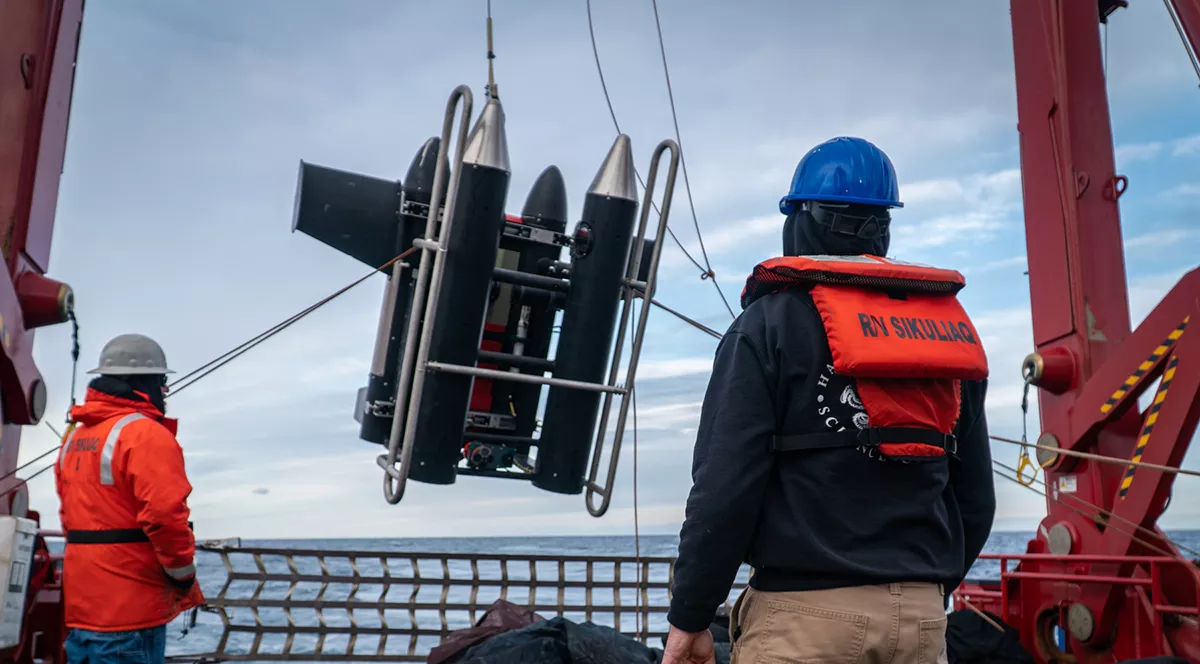In Situ Ichthyoplankton Imaging System (ISIIS)

ISIIS 3.0
The ISIIS was developed in collaboration between the University of Miami's Rosenstiel School of Atmospheric and Marine Science (RSMAS) and the subsea engineering company, Bellamare, LLC, located in San Diego CA. Continued development involves Oregon State University. Funding was provided by the National Science Foundation, NOAA, UNH Large Pelagics Center, and UM Maytag Chair of Ichthyology.

ISIIS is an underwater imaging system aimed at capturing in situ, real time images of marine zooplankton of relatively low abundance such as fish larvae and fragile gelatinous organisms. The first prototype, delivered in 2007, was attached to a relatively simple vehicle towed by an oceanographic vessel at a speed of five knots. The vehicle, and associated imaging system and sensors, was moved up and down through the water column by paying cable in and out via an oceanographic winch. Subsequently, a new vehicle was designed with the capacity of self-undulation using motor actuated dive fins. The vehicle frame is divided into four compartmentalized enclosures with imaging and optical equipment seamlessly integrated into the ventral housings and environmental sensors and electronics in the dorsal housings. Sensitive instrument equipment is isolated from the aluminum frame by using separating suspension and vibration-absorbing materials. The dive fins are positioned ahead of the vehicle aligned with the tow point and away from the imaging pods. The vehicle is designed to undulate between the surface and a maximum depth of 200 m.
The ISIIS system utilizes a high-resolution line-scanning camera with a Light Emitting Diode (LED) light source, modified by plano-convex optics, to create a collimated light field to backlight a parcel of water. The imaged parcel of water passes between the forward portions of two streamlined pods (UW housings), and thereby remains unaffected by turbulence. The resulting very high-resolution image is of plankton in their natural position and orientation. When a sufficient volume of water is imaged this way, quantification of density and fine-scale distribution is possible. ISIIS is capable of imaging a maximum of 162 L of water per second (when flying at 5 knots) with a pixel resolution of 70 µm, imaging particles from 1 mm to 13 cm in size. The imaging data and associated oceanographic data are ported to the surface via 0.322 in copper/fiber optic oceanographic wire and recorded onto a computer-controlled raid array.
System & image analysis description
- Cowen RK, Guigand CM. 2008. In situ Ichthyoplankton Imaging System (ISIIS): system design and preliminary results. Limnol Oceanogr Methods. 6: 126-132
- Tsechpenakis G, Guigand CM, Cowen RK. 2008. Machine Vision assisted In Situ Ichthyoplankton Imaging System. Sea Technology 49: 15-20
- Tsechpenakis G, Guigand CM, Cowen RK. 2007. Image analysis techniques to accompany a new In Situ Ichthyoplankton Imaging System (ISIIS). IEEE OCEANS, Aberdeen, Scotland
Publications Utilizing ISIIS Data
- Axler KE, Sponaugle S, Briseño-Avena C, Hernandez FJ, Warner SJ, Dzwonkowski B, Dykstra SL, Cowen RK. 2020. Fine-scale larval fish distributions and predator-prey dynamics in a coastal river-dominated ecosystem. Mar Ecol Progr Ser.
- Swieca K, Sponaugle S, Briseño-Avena C, Schmid M, Cowen RK, Brodeur R. 2020. Changing with the tides: fine-scale prey availability and predation pressure near a tidally-modulated river plume. Mar Ecol Progr Ser
- Greer AT, Boyette AD, Cruz VJ, Cambazoglu MK, Dzwonkowski B, Chiaverano LM, Dykstra SL, Briseño-Avena C, Cowen RK, Wiggert JD. In Press. Contrasting fine-scale distributional patterns of zooplankton driven by the formation of a diatom-dominated thin layer. Limnol Oceanogr
- Schmid M, Cowen RK, Robinson KL, Luo J, Briseño-Avena C, Sponaugle S. 2020. Prey and predator overlap at the edge of a mesoscale eddy: fine-scale, in-situ distributions to inform our understanding of oceanographic processes. Sci Reports 10:921
- Gleiber MR, Sponaugle S, Robinson KL, Cowen RK. 2020. Food web constraints on larval growth in subtropical coral reef and pelagic fishes. Mar Ecol Progr Ser
- Greer AT, Briseño-Avena C, Deary AL, Cowen RK, Hernandez FJ, Graham WM. 2017. Associations between lobster phyllosoma and gelatinous zooplankton in relation to oceanographic properties in the northern Gulf of Mexico. Fish Oceanogr 26: 693-704
- Greer AT, Woodson CB, Smith CE, Guigand CM, Cowen RK. 2016. Scaling from individual plankton to marine ecosystems: Examining mesozooplankton patch structure and its implications for trophic interactions in the northern Gulf of Mexico. J Plankton Res 38:1115-1134
- Greer AT, Cowen RK, Guigand CM, Hare JA. 2015. Fine-scale planktonic habitat partitioning at a shelf-slope front revealed by a high-resolution imaging system. J Mar Sys 142: 111-125
- Timmerman AHV, McManus MA, Cheriton OM, Cowen RK, Greer AT, Kudela RM, Ruttenberg KC, Sevadjian JV. 2014. Hidden thin layers of toxic diatoms in a coastal bay. Deep-Sea Res. II. Top Stud Oceanogr 101: 129-140
- Greer AT, Cowen RK, Guigand CM, Hare JA, Tang D. 2014. The role of internal waves in larval fish interactions with potential predators and prey. Prog Oceanogr 127: 47-61
- Luo JY, Grassian B, Tang D, Irisson J-O, Greer AT, Guigand CM, McClatchie S, Cowen RK. 2014. Environmental drivers of the fine-scale distribution of a gelatinous zooplankton community across a meso-scale front. Mar Ecol Progr Ser 510: 129-149. doi: 10.3354/meps10908
- Sevadjian JC, McManus MA, Ryan JP, Greer AT, Cowen RK, Woodson CB. 2014. Across-shore variability in plankton layering and abundance on the northern Monterey Bay inner shelf. Cont Shelf Sci 72: 138-151
- Cowen RK, A Greer, C Guigand, JA Hare, DE Richardson, H Walsh. 2013. Evaluation of the In Situ Ichthyoplankton Imaging System (ISIIS): comparison with the traditional (bongo net) sample sampling. US Fish Bull 111: 1-12
- Greer AT, Cowen RK, Guigand CM, McManus MA, Sevadjian J, Timmerman AHV. 2013. Interrelationships between phytoplankton thin layers and fine-scale spatial distributions of two trophic levels of zooplankton. J Plank Res 35: 939-956
- McClatchie S, Cowen RK, Nieto KM, Greer A, Luo JY, Guigand C, Demer DA, Griffith DA, Rudnick DL. 2012. Resolution of fine biological structure including small narcomedusae across a front in the Southern California Bight. J Geophys Res 117: C04020